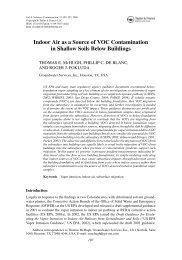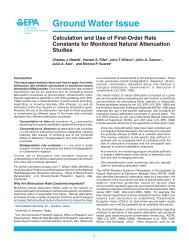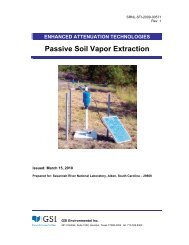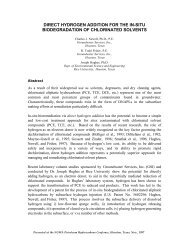Parameter Estimation Guidelines for Risk-Based Corrective Action ...
Parameter Estimation Guidelines for Risk-Based Corrective Action ...
Parameter Estimation Guidelines for Risk-Based Corrective Action ...
You also want an ePaper? Increase the reach of your titles
YUMPU automatically turns print PDFs into web optimized ePapers that Google loves.
Groundwater Services, Inc.<br />
Affected Soil Zone<br />
S w<br />
Groundwater Source<br />
Term Location<br />
Groundwater Flow<br />
S d<br />
Affected<br />
Groundwater Plume<br />
Groundwater<br />
Source Area:<br />
Constituent influent to<br />
groundwater system<br />
Groundwater<br />
Transport Area:<br />
Lateral transport / attenuation of<br />
constituents in groundwater system<br />
SELECTION OF GROUNDWATER MODEL INPUT PARAMETERS<br />
For use of Domenico groundwater solute transport model (see Equations LT-1a and LT-1b, Figure 3),<br />
select source term location, dimensions, and concentration as follows:<br />
1) Groundwater Source Term Location<br />
The source term corresponds to a vertical source plane, normal to the direction of groundwater flow, located at<br />
the downgradient limit of the area serving as the principal source of constituent release to groundwater (e.g.,<br />
affected unsaturated zone soils, NAPL plume, land disposal unit, spill area, etc.). In the absence of such data,<br />
the source term should be located at the point of the maximum measured plume concentration(s). Distances<br />
to downgradient points of exposure (POEs) should then be measure from this location along the principal<br />
direction of groundwater flow.<br />
2) Groundwater Source Term Width, S w<br />
The width of the source term should be matched to the greater of the following dimensions:<br />
i) the measured groundwater plume width, (as defined by Tier 1 limits) normal to the principal<br />
direction of groundwater flow at the designated source term location.<br />
ii) the maximum width of the affected soil zone, normal to the principal groundwater flow direction.<br />
3) Groundwater Source Term Thickness, S d<br />
The thickness of the source term should be matched to either:<br />
i) the measured vertical extent of the affected groundwater plume, at the designated source term<br />
location.<br />
ii) in the absence of actual site measurements establishing the vertical extent of the affected<br />
groundwater plume, the full saturated thickness of the water-bearing unit at this location.<br />
4) Groundwater Source Term Concentration, C s<br />
To calculate baseline risk levels, the user must also provide a groundwater source concentration <strong>for</strong> each<br />
constituent of concern (COC). The vertical plane source functions as a constant source term, applying these<br />
input concentrations to all groundwater flowing through the source location. Under a Tier 2 evaluation, the<br />
source concentration of each COC may be defined as follows:<br />
i) use the maximum concentration of each COC detected at the source location or<br />
ii) if multiple sampling locations are available to characterize plume concentrations across the source<br />
term width Sw, calculate a weighted average source concentration <strong>for</strong> each constituent across this<br />
plume transect based on time-consistent measurements.<br />
FIGURE 4. DEFINITION OF SOURCE TERM FOR USE IN DOMENICO SOLUTE TRANSPORT MODEL<br />
NGWA Petroleum Hydrocarbons Conference 8 <strong>Parameter</strong> <strong>Estimation</strong> <strong>Guidelines</strong><br />
Houston, Texas, November 1996<br />
<strong>for</strong> RBCA Modeling






